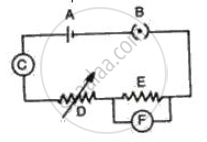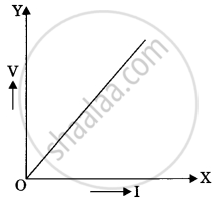Advertisements
Advertisements
प्रश्न
Define ampere and volt with respect to Ohm’s law.
उत्तर
Ampere: It is the S.I. unit of current. If a current flows in a conductor of resistance of 1Ω, when the potential difference across its ends is 1 volt, the current is said to be 1 ampere, i.e.,
1 ampere = 1 volt/1 ohm
Volt: It is the S. I. unit of potential difference. If a current of 1 ampere flows in a conductor of resistance 1 ohm, then potential difference across its ends is said to be 1 volt, i.e.,
1 volt = 1 ampere × 1 ohm.
APPEARS IN
संबंधित प्रश्न
Name the unit of electrical resistance and give its symbol.
The graph between V and I for a conductor is a straight line passing through the origin.
What should remain constant in a statement of this law?
A resistance of 40 ohms and one of 60 ohms are arranged in series across 220 volt supply. Find the heat in joules produced by this combination of resistances in half a minute.
What length of copper wire of resistivity 1.7 × 10-8 Ω m and radius 1 mm is required so that its resistance is 2Ω?
Fig. represents the circuit used for the verification of ohm's law. Label the different parts from A and F. State the function of each.

The filament of a bulb takes a current 100 mA when potential difference across it is 0.2 V. When the potential difference across it becomes 1.0 V, the current becomes 400 mA. Calculate the resistance of filament in each case and account for the difference.
Ohm’s law states the relationship between power and voltage.
Which of the following is correct for V-I graph of a good conductor?
The slope of voltage (V) versus current (I) is called:

A current of 2amp flowing through a conductor produced 80 joule of heat in 10 sec. The resistance of the conductor is:-
